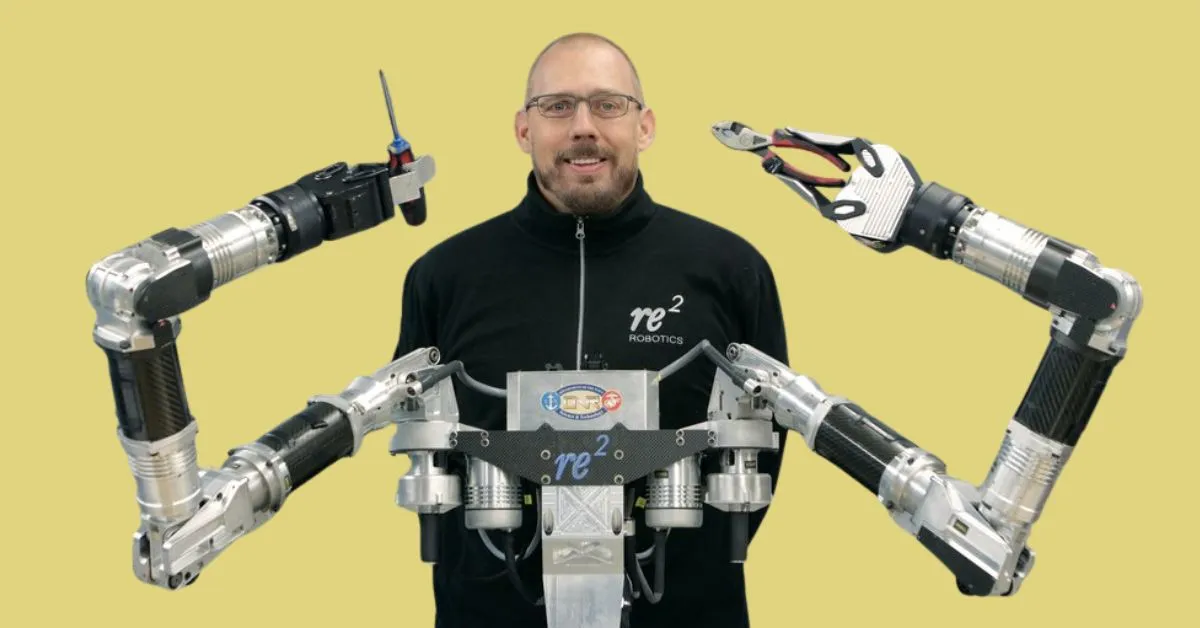In the ever-evolving world of robotics and artificial intelligence (AI), few individuals have made as significant an impact as Matt Senske, a key figure at Sarcos Technology and Robotics Corporation. As the Chief Executive Officer (CEO) of Sarcos, Senske has spearheaded efforts to revolutionize industries through advanced robotic systems, focusing on increasing human capabilities while minimizing risks and maximizing efficiency. His leadership at Sarcos Technology represents a unique fusion of visionary thinking, technical expertise, and practical application—creating a future where robotics and humans collaborate seamlessly.
In this article, we will explore Matt Senske’s journey in the robotics industry, delve into the groundbreaking work at Sarcos Technology, and look at the potential implications of their innovative technologies for the future of industries such as manufacturing, defence, healthcare, and logistics.
Matt Senske’s Background and Vision
Before delving into his work at Sarcos, it’s essential to understand Matt Senske’s professional background and the vision that drives his leadership. Senske has been with Sarcos since 2019 and has brought a wealth of experience in both the technology sector and executive leadership. Before joining Sarcos, he held leadership roles at Doosan Industrial Vehicle America Corporation, AmeriGas, and UTi Worldwide, honing his ability to scale companies, drive operational excellence, and deliver cutting-edge solutions.
Senske’s vision for Sarcos revolves around enhancing human performance through robotics—particularly in dangerous, high-stakes environments like construction sites, military operations, and industrial applications. By combining robotics with human intelligence and dexterity, Senske believes that technology can solve some of the world’s most pressing challenges. This philosophy is central to the development of Sarcos’s signature product lines, which include dexterous robotic exoskeletons and teleoperated robots.
Through his leadership, Senske has aimed to position Sarcos not just as a robotics company but as a pioneer in human-robot collaboration. Sarcos’s mission is to bring these advanced technologies to market in a way that empowers workers rather than replaces them. This human-centric focus sets the company apart in an industry often defined by automation and the fear of job displacement.
The Sarcos Technology and Robotics Corporation: A Snapshot
Sarcos Technology and Robotics Corporation is a leader in the field of robotics, specializing in designing and manufacturing wearable robotic systems and teleoperated robots that work in conjunction with human operators. The company was founded in 1983, but it gained significant attention in recent years under Matt Senske’s leadership as it shifted its focus towards developing innovative solutions that enhance human strength, endurance, and precision.
The company’s approach is not about replacing workers with machines. Instead, Sarcos designs robotic systems that enable workers to perform tasks that would otherwise be too dangerous, physically taxing, or complex. The goal is to create technologies that augment human capabilities and ensure that workers are protected while boosting productivity and reducing physical strain.
Sarcous’s product offerings are highly diverse, but two key innovations stand out:
- Dexterous Robotic Exoskeletons: These wearable devices are designed to assist human operators in lifting and handling heavy objects. They augment human strength and endurance, allowing workers to lift, carry, or manipulate loads that would be otherwise impossible to manage manually. Unlike traditional exoskeletons, which offer limited range and mobility, Sarcos’s exoskeletons are highly versatile, allowing for fluid, natural movement without limiting flexibility or agility.
- Teleoperated Robotic Systems: These systems are designed to be operated remotely and can perform tasks that are hazardous for humans. By using a combination of sensors, cameras, and AI, operators can control robots with a high degree of precision, making them ideal for dangerous environments like battlefields, disaster zones, or hazardous work sites.
Together, these products are reshaping the relationship between human labour and robotics, opening up new possibilities for industries ranging from defence and aerospace to logistics and manufacturing.
Key Technologies at Sarcos
Under Matt Senske’s leadership, Sarcos has made significant advancements in several cutting-edge technologies that aim to revolutionize industries by enhancing safety, efficiency, and productivity. Let’s take a closer look at some of the most exciting developments.
The Sarcos Guardian XO™ Exoskeleton
Perhaps the most well-known product developed by Sarcos is the Guardian XO™, a full-body, powered exoskeleton that augments human strength and endurance. The Guardian XO™ is designed to allow workers to lift, move, and manipulate heavy loads with ease, reducing strain and minimizing the risk of injury. It can lift to 200 pounds, making it suitable for tasks in industries such as construction, warehousing, logistics, and even disaster recovery.
The exoskeleton’s key feature is its human-like range of motion. Unlike traditional industrial machines that require human operators to remain stationary or confined to a single area, the Guardian XO™ offers the user unprecedented freedom of movement. The exoskeleton’s joints, powered by a series of motors and actuators, mimic the body’s natural motions, ensuring that operators can perform complex tasks with high precision and fluidity.
What makes the Guardian XO™ stand out is its hybrid design—combining advanced robotics with human dexterity and intuition. The exoskeleton provides physical power without diminishing the operator’s cognitive functions. It’s a perfect example of human-robot collaboration, where technology enhances human abilities without overshadowing them.
The Sarcos Guardian® S System
The Guardian® S is a teleoperated robotic system designed to perform dangerous and physically demanding tasks remotely. The system consists of a wearable robotic suit that mimics the operator’s movements and allows them to control the robot from a safe distance. This system can be used in a variety of applications, including hazardous material handling, remote inspections, search-and-rescue missions, and military operations.
What sets the Guardian® S apart from traditional remote-controlled robots is its human-like dexterity and precision. The suit provides real-time feedback to the operator, enhancing situational awareness and making remote interactions more intuitive. By combining advanced sensors, high-definition cameras, and AI-driven controls, Sarcos has created a system that can navigate complex environments and perform intricate tasks with minimal delay.
The Guardian® S system has the potential to be used in environments where it’s too dangerous for humans to go, such as areas contaminated by hazardous materials, deep-sea exploration, or battlefields. In these contexts, the ability to perform tasks remotely without risking human lives can be a game-changer.
Artificial Intelligence and Machine Learning Integration
One of the defining aspects of Sarcos’s products is their integration with artificial intelligence (AI) and machine learning (ML) algorithms. These technologies enable the exoskeletons and robotic systems to adapt to different environments, tasks, and operators, providing an experience that feels intuitive and natural.
The incorporation of AI also helps optimize the performance of the robots. For instance, robotic systems can learn from each task and improve their efficiency over time. They can also adapt to the specific physical capabilities and preferences of the human operator, allowing for personalized adjustments that improve comfort and reduce fatigue.
In addition, AI-powered systems enable the detection of anomalies, such as potential malfunctions or safety hazards, making Sarcos’s products not only more effective but also safer to use.
Industry Applications of Sarcos Technology
The products developed by Sarcos have far-reaching implications for several industries. Matt Senske’s leadership and vision have driven the company to explore numerous use cases across sectors that stand to benefit from advanced robotic solutions.
Manufacturing and Warehousing
In the manufacturing and logistics sectors, the demand for labour-saving, ergonomic solutions is higher than ever. As companies seek ways to improve efficiency while reducing workplace injuries, Sarcos’s exoskeletons offer a solution that allows workers to lift heavier loads with less risk of strain or injury. The use of robotic exoskeletons can also reduce fatigue, making it easier for workers to maintain productivity during long shifts.
Moreover, Sarcos’s teleoperated robots are ideal for hazardous work environments, such as chemical plants or construction sites, where heavy machinery and dangerous tasks present a risk to human workers. These robots can take on tasks like handling hazardous materials or performing inspections, thereby protecting workers from harm.
Defence and Aerospace
Sarcos’s technology is also finding its place in defence and aerospace applications. The ability to operate heavy machinery remotely is a game-changer in military operations, where soldiers often face dangerous and physically demanding tasks. The Guardian® S system could be used in bomb disposal, reconnaissance missions, or search-and-rescue operations in conflict zones, all while minimizing the risk to personnel.
In addition, the exoskeletons can augment soldier strength and endurance, enabling them to carry heavier loads over longer distances without experiencing fatigue, which could improve their operational effectiveness and safety.
Healthcare and Elderly Care
In healthcare, robotics is being used to provide assistive devices for individuals with limited mobility. Sarcos’s exoskeletons have the potential to assist people with disabilities, enabling them to perform tasks that would otherwise be impossible. By augmenting the user’s strength and mobility, these devices could help those suffering from conditions like paralysis or muscular dystrophy regain independence.
The Future of Robotics: Human-Robot Collaboration
Matt Senske’s work at Sarcos Technology is emblematic of a broader trend in robotics: the emphasis on human-robot collaboration rather than automation. As AI and robotics continue to advance, there will undoubtedly be significant changes to the workforce. However, the future of robotics—according to Senske—is one where machines and humans work in tandem, each complementing the other’s strengths.
This vision aligns with the growing emphasis on augmentative technologies, where robots enhance human capabilities without replacing them. Whether it’s improving worker safety, enhancing productivity, or enabling previously impossible feats, Sarcos is paving the way for a future where human intelligence and robotic precision coexist harmoniously.
Conclusion
Matt Senske’s leadership at Sarcos Technology and Robotics Corporation is helping shape the future of robotics, with a particular focus on human-robot collaboration. By developing innovative exoskeletons and teleoperated robotic systems, Sarcos is bringing new possibilities to industries that rely on manual labour and dangerous tasks. As technology continues to advance, the work being done at Sarcos will undoubtedly play a pivotal role in reshaping the future of human work, productivity, and safety. Through his vision and commitment to innovation, Senske is demonstrating that the future of robotics is not about replacing humans but about empowering them to do more and do it safely.
FAQs:
What is Sarcos Technology?
Sarcos Technology develops advanced robotic systems that enhance human capabilities, focusing on safety, efficiency, and human-robot collaboration.
Who is Matt Senske?
Matt Senske is the CEO of Sarcos Technology, leading the company’s innovations in robotics and human-centred technology.
What products does Sarcos create?
Sarcos creates powered exoskeletons and teleoperated robotic systems to assist in hazardous environments and improve human performance.
How do Sarcos exoskeletons work?
Sarcos exoskeletons augment human strength and endurance, allowing workers to lift heavy loads with minimal strain and fatigue.
What industries benefit from Sarcos robotics?
Industries like manufacturing, defence, healthcare, and aerospace benefit from Sarcos’s robotic solutions for increased productivity and safety.











